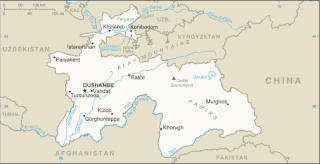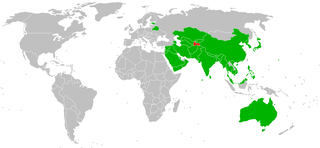
Tajikistan, officially the Republic of Tajikistan, is a landlocked country in Central Asia. It has an area of 143,100 km2 (55,300 sq mi) and an estimated population of 9,537,645 people. Its capital and largest city is Dushanbe. It is bordered by Afghanistan to the south, Uzbekistan to the west, Kyrgyzstan to the north and China to the east. The traditional homelands of the Tajik people include present-day Tajikistan as well as parts of Afghanistan and Uzbekistan.

Tajikistan harkens to the Samanid Empire (819–999). The Tajik people came under Russian rule in the 1860s. The Basmachi revolt broke out in the wake of the Russian Revolution of 1917 and was quelled in the early 1920s during the Russian Civil War. In 1924 Tajikistan became an Autonomous Soviet Socialist Republics of the Soviet Union, the Tajik ASSR, within Uzbekistan. In 1929 Tajikistan was made one of the component republics of the Soviet Union – Tajik Soviet Socialist Republic – and it kept that status until gaining independence 1991 after the dissolution of the Soviet Union.

Tajikistan is nestled between Kyrgyzstan and Uzbekistan to the north and west, China to the east, and Afghanistan to the south. Mountains cover 93 percent of Tajikistan's surface area. The two principal ranges, the Pamir Mountains and the Alay Mountains, give rise to many glacier-fed streams and rivers, which have been used to irrigate farmlands since ancient times. Central Asia's other major mountain range, the Tian Shan, skirts northern Tajikistan. Mountainous terrain separates Tajikistan's two population centers, which are in the lowlands of the southern and northern sections of the country. Especially in areas of intensive agricultural and industrial activity, the Soviet Union's natural resource utilization policies left independent Tajikistan with a legacy of environmental problems.

The economy of Tajikistan is dependent upon agriculture and services. Since independence, Tajikistan has gradually followed the path of transition economy, reforming its economic policies. With foreign revenue precariously dependent upon exports of cotton and aluminium, the economy is highly vulnerable to external shocks. Tajikistan's economy also incorporates a massive black market, primarily focused on the drug trade with Afghanistan. Heroin trafficking in Tajikistan is estimated to be equivalent to 30-50% of national GDP as of 2012.

Tajiks are a Persian-speaking Iranian ethnic group native to Central Asia, living primarily in Afghanistan, Tajikistan, and Uzbekistan. Tajiks are the largest ethnicity in Tajikistan, and the second-largest in Afghanistan and Uzbekistan. They speak varieties of Persian, a Western Iranian language. In Tajikistan, since the 1939 Soviet census, its small Pamiri and Yaghnobi ethnic groups are included as Tajiks. In China, the term is used to refer to its Pamiri ethnic groups, the Tajiks of Xinjiang, who speak the Eastern Iranian Pamiri languages. In Afghanistan, the Pamiris are counted as a separate ethnic group.

Dushanbe is the capital and largest city of Tajikistan. As of January 2020, Dushanbe had a population of 863,400 and that population was largely Tajik. Until 1929, the city was known in Russian as Dyushambe, and from 1929 to 1961 as Stalinabad, after Joseph Stalin. Dushanbe is located in the Gissar Valley, bounded by the Gissar Range in the north and east and the Babatag, Aktau, Rangontau and Karatau mountains in the south, and has an elevation of 750–930 m. The city is divided into four districts, all named after historical figures: Ismail Samani, Avicenna, Ferdowsi, and Shah Mansur.

Tajik, also called Tajiki Persian, Tajiki, and Tadzhiki, is the variety of Persian spoken in Tajikistan and Uzbekistan by Tajik people. It is closely related to neighbouring Dari with which it forms a continuum of mutually intelligible varieties of the Persian language. Several scholars consider Tajik as a dialectal variety of Persian rather than a language on its own. The popularity of this conception of Tajik as a variety of Persian was such that, during the period in which Tajik intellectuals were trying to establish Tajik as a language separate from Persian, prominent intellectual Sadriddin Ayni counterargued that Tajik was not a "bastardised dialect" of Persian. The issue of whether Tajik and Persian are to be considered two dialects of a single language or two discrete languages has political sides to it.

Emomali Sharipovich Rahmonov is the 3rd President of Tajikistan since 16 November 1994. Previously, he served as the Chairman of the Supreme Assembly of Tajikistan, as the de facto head of state from 20 November 1992 to 16 November 1994. Since 18 March 1998, he has also served as the leader of the centre-left People's Democratic Party of Tajikistan, which dominates the Parliament of Tajikistan. On 30 September 1999, he was elected vice-president of the UN General Assembly for a one-year term.

The Tajik Soviet Socialist Republic, also commonly known as Soviet Tajikistan and Tajik SSR, was one of the constituent republics of the Soviet Union which existed from 1929 to 1991 located in Central Asia.

Tajikistan is divided into

The Kuhistani Badakhshan Autonomous Region is an autonomous region in eastern Tajikistan, in the Pamir Mountains, which makes up 45% of the land area of the country, but only 3% of its population.

The Tajikistan national football team represents Tajikistan in international football and is controlled by the Tajikistan Football Federation, the governing body for football in Tajikistan. Tajikistan's home ground is the Pamir Stadium in Dushanbe.

The Tajikistani Civil War, also known as the Tajik Civil War, began in May 1992 when regional groups from the Garm and Gorno-Badakhshan regions of Tajikistan rose up against the newly-formed government of President Rahmon Nabiyev, which was dominated by people from the Khujand and Kulob regions. The rebel groups were led by a combination of liberal democratic reformers and Islamists, who would later organize under the banner of the United Tajik Opposition. The government was supported by Russian border guards.

As of 2020, the regions of Tajikistan are subdivided into 47 districts, not including 4 districts belonging to the capital city Dushanbe, and 18 cities of regional subordination. Before ca. 2017, there were 58 districts. The districts are further subdivided into rural municipalities called jamoats, which in turn are further subdivided into villages.

Tajikistan first participated at the Olympic Games as an independent nation in 1996, and has sent athletes to compete in every Summer Olympic Games since then. The nation has also competed at the Winter Olympics since 2002. To date, Andrei Drygin is one of two people ever to have represented Tajikistan at the Winter Olympic Games, being his country's sole competitor in 2002, 2006, and 2010.

The jamoats of Tajikistan are the third-level administrative divisions, similar to communes or municipalities, in the Central Asian country of Tajikistan. As of January 2020, there are 368 rural jamoats, 65 towns and 18 cities in Tajikistan. Each jamoat is further subdivided into villages

This page shows the Tajikistan national football team's results in International Matches, as recognized by FIFA:
Visitors to Tajikistan must obtain a visa from one of the Tajikistan diplomatic missions unless they come from one of the visa exempt countries or countries whose citizens are eligible for an electronic visa or a visa on arrival.

The COVID-19 pandemic in Tajikistan is part of the worldwide pandemic of coronavirus disease 2019 caused by severe acute respiratory syndrome coronavirus 2. The virus was confirmed to have spread to Tajikistan when its index cases, in Dushanbe and Khujand, were confirmed on 30 April 2020.
This article provides details of international football games played by the Bangladesh national football team from 2000 to 2019.
















